Pearl gourami are one of a number of fish in the gourami family. These include the betta fish, paradise fish, and many other popular aquarium pets that you might not realize are related.
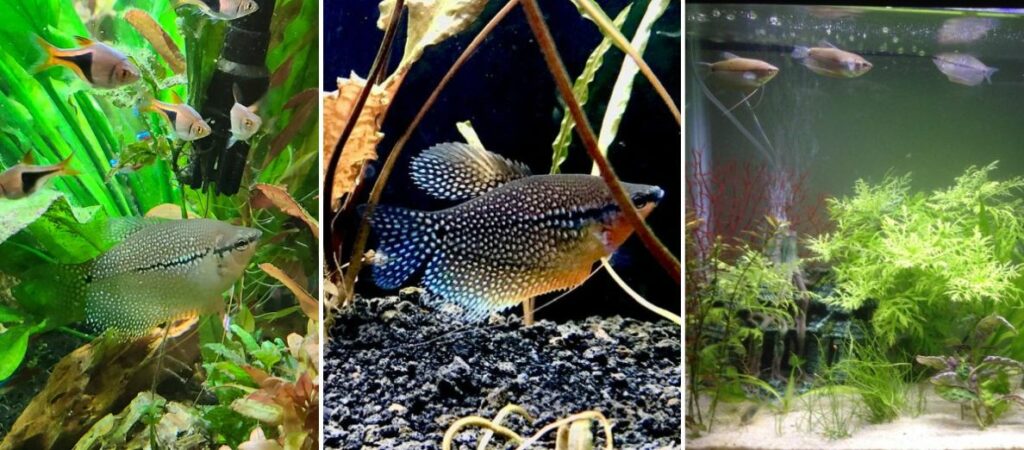
As labyrinth fish, bettas and gouramis have the ability to breathe air, helping them thrive even in poor water conditions. It’s just one of many reasons why the beautiful pearl gourami is as popular as it is!
What are Pearl Gourami?
There are many different types of gourami out there. They are one of the most diverse and beautiful of the commonly available freshwater aquarium fish you’ll see in pet stores. In fact, we’ve even covered the pearl gourami very briefly in our 13 Popular & Beautiful Types of Gourami Species Guide!
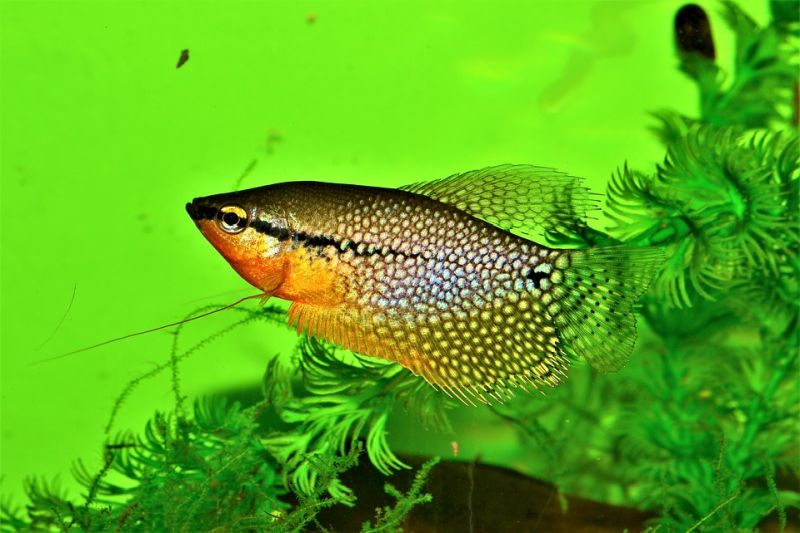
However this fish is popular enough that it deserves to have a guide to itself. The pearl gourami is an average sized member of the Trichopodus genus, a group that also includes the snakeskin, moonlight, and blue gourami.
All of these have been a part of the aquarium hobby for many decades now. However they are originally from Southeast Asia; specifically Thailand, Malaysia, and Indonesia in the case of the pearl gourami.
Many gouramis tend to be semi-aggressive as they mature, especially the larger kinds. But the pearl gourami is the most peaceful of the lot. Which is fortunate because it is also one of the most beautifully colored. It is easy to see how it earns its other common names of lace gourami and mosaic gourami!
The intricate patterns are very elegant and only further highlighted by the robin red breast of the male. You may even see a faint green or purple sheen in fish that are in good condition!
Pearl gouramis are not only easy to keep despite their delicate appearance; they are also a very easy gourami to breed! So what is there to know about pearl gourami care?
Golden Pearl Gourami
By the way, there is a new color morph of the pearl gourami on the block that might be lurking at your local fish store! While they still are not super common the golden pearl gourami is well worth keeping an eye out for.
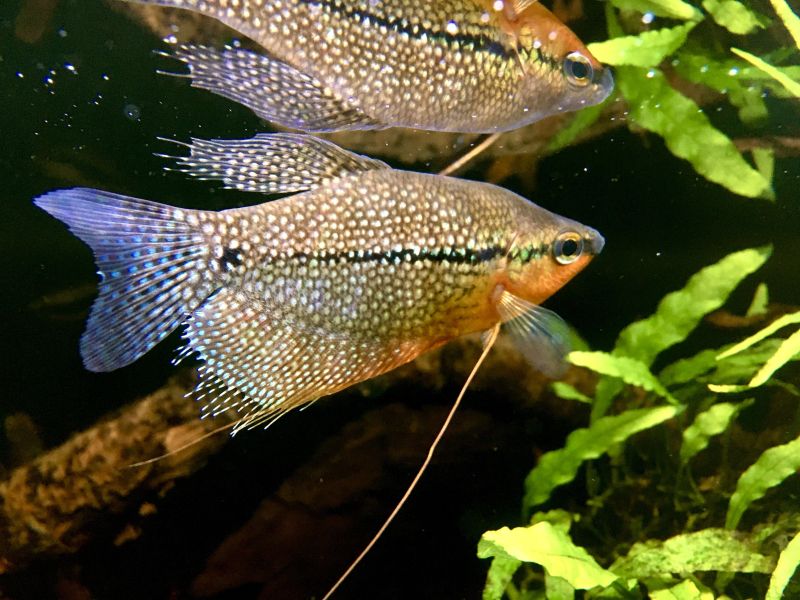
Golden pearl gouramis are believed to be a hybrid between the larger and more aggressive blue gourami (Trichopodus trichopterus) and the normal pearl gourami. So it is possible it may be both larger and meaner as an adult than standard pearl gouramis. However the golden hues pair even nicer with the ruby red of the males and silver belies of females!
- Common Names: Pearl Gourami, Lace Gourami, Mosaic Gourami, Golden Pearl Gourami, Blue Pearl Gourami
- Scientific Name: Trichopodus leerii
- Origin: Southeast Asia
- Length: 4 to 5 inches
- Aquarium Size: 30+ gallons
- Temperament: Peaceful
- Ease of Care: Easy
Pearl Gourami Fish Care
Pearl Gourami Tank Size
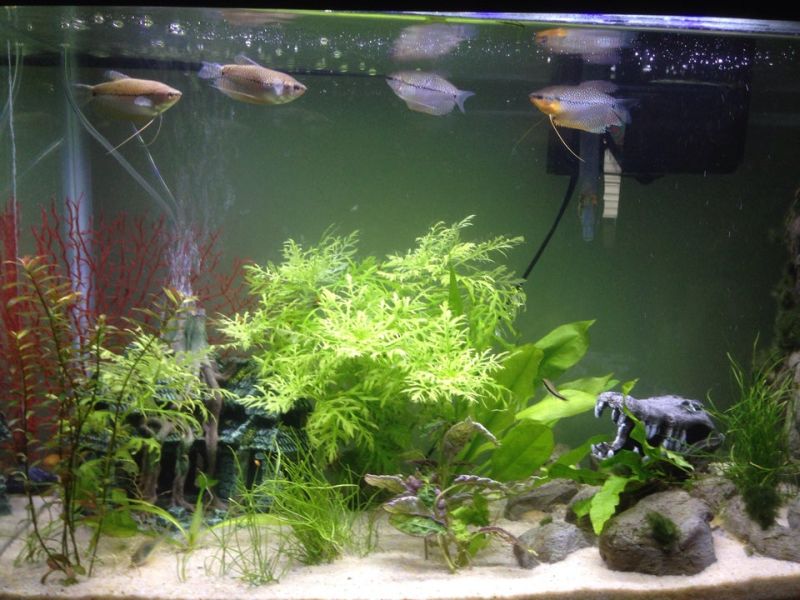
Given how manageable pearl gourami size is, you don’t need an especially large tank for these fish. However you don’t want to choose an aquarium that is too small, either. 10 and 20 gallon setups are unfortunately too small of a pearl gourami tank size.
You should be looking for at least a 30 gallon tank for one or two pearl gouramis, with larger being better whenever possible.
Full Grown Pearl Gourami Size
A full grown pearl gourami will be around 4 to 5 inches long. They are solidly medium sized aquarium fish; not too large but not very small, either!
Pearl Gourami Lifespan
Like many aquarium fish, the pearl gourami will live for a few years. But they are not as long-lived as pacus, goldfish, and other record-holding fish. An average pearl gourami lifespan is around 4 to 6 years. You may have a rare fish that reaches 8 years but that is very unexpected.
Water Conditions for Pearl Gouramis
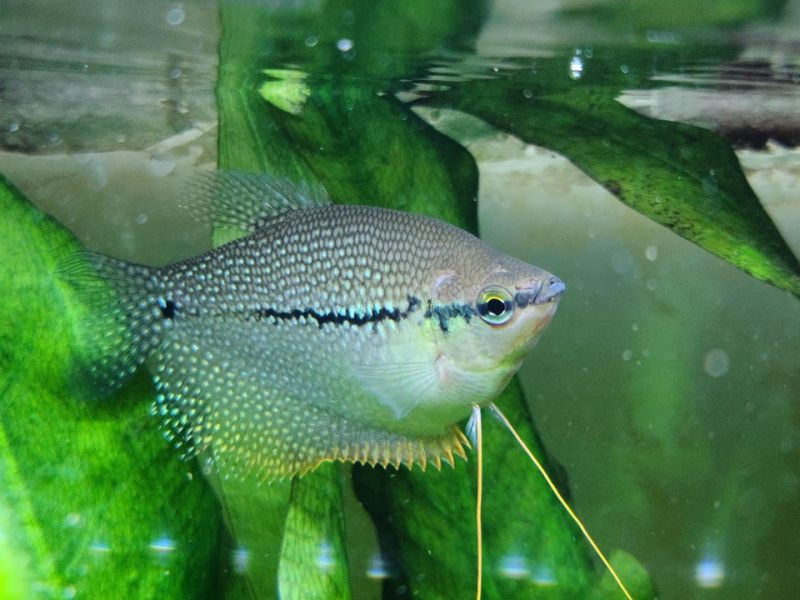
Pearl gouramis are from Southeast Asia, which gives us significant clues on the water conditions they prefer. Like most fish from this region they are found in very warm, acidic water that is typically soft in chemistry. A pH of 5.5 (acidic) to 7.0 (neutral) is best for them.
They have been tank raised for many years so they will also thrive even in alkaline water (7.0+). But they have better health, better colors,and are much more likely to breed in soft, acidic water conditions. Even slight shifts towards acidity can help, such as by adding driftwood, peat, and other sources of plant tannins to your aquarium!
Pearl gouramis are not too sensitive to ammonia, nitrite, or nitrate. However they should not be the first fish you add to a newly set up fish tank. If you don’t like fish-in cycling, you can always fishless cycle using liquid ammonia. But cycling new tanks with guppies and other hardy fish is still a tried and true method. And your pearl gouramis will get along with just about any fish you added in the beginning!
Like all labyrinth fish (bettas and gouramis) the pearl gourami can breathe atmospheric air using its labyrinth organ. This is a modified gill structure that works like a primitive lung. Since gouramis live in conditions where the water is shallow and hot, dissolved oxygen levels can often get dangerously low.
However, these are the same water conditions that insect larvae, a favored food source, tend to be found in. So gouramis and bettas adapted to thrive in these bodies of water!
While you should not deprive your fish tank of oxygen, you should keep the water on the warm side for all gouramis, including pearl gouramis. Temperatures of 75-82℉ are perfect for them. And if you are looking to stimulate a pair of pearl gouramis to breed, raising the temperature further to around 84-86℉ can help move things along!
Feeding Pearl Gouramis
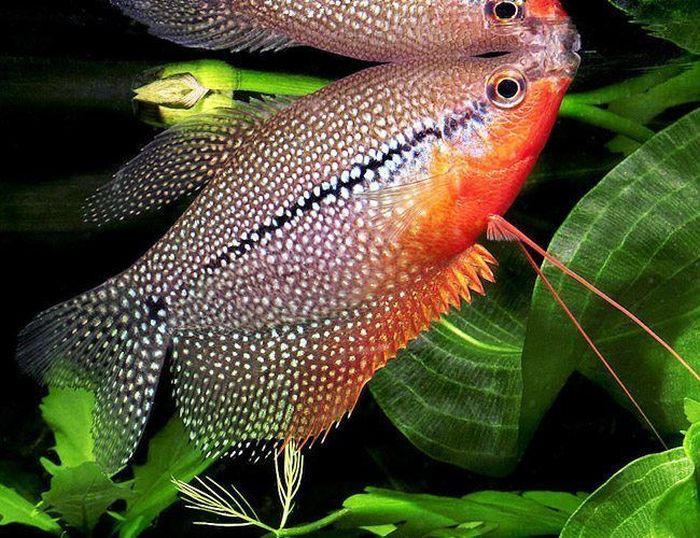
Pearl gouramis are not at all difficult to feed so long as you choose food items that are a good fit for their tiny mouths. Gouramis in general have a hard time with medium and large pellets and they are toothless so they can’t just pick them apart.
Therefore, any prepared food should be mostly flakes and pellets of the right size for them. Presoaking any pellets in water is also a good idea if they are hard right out of the can.
Pearl gouramis are carnivorous fish, feeding mostly on insect larvae, worms, aquatic crustaceans, and other tiny invertebrates they find among thickets of plant growth. So we want to stick to prepared food blends that are rich in animal protein!
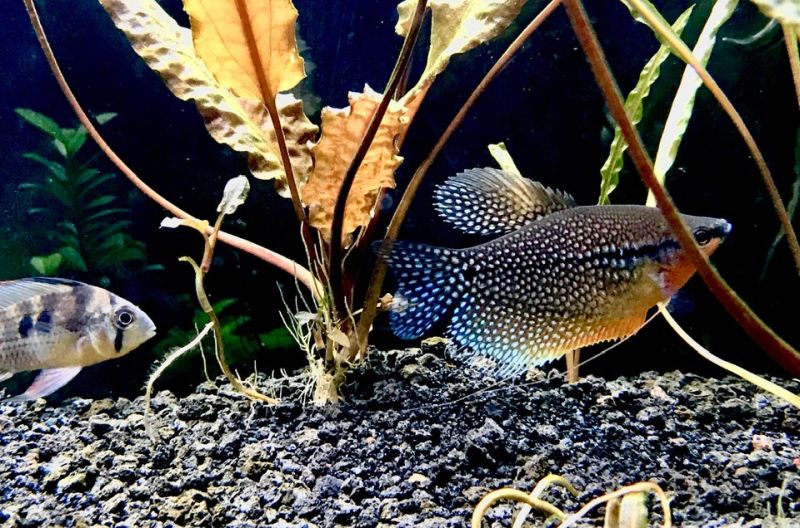
Look for whole fish, shrimp, squid, and other ingredients on the label when shopping for pearl gourami food! You can even find blends nowadays like Fluval Bug Bites that contain whole insect larvae as a main ingredient! And stay away from blends that use potato, wheat, soy, and other cheap farm fillers that do nothing for your pearl gourami.
Definitely supplement your pearl gourami food with frozen and live foods as well! Bloodworms are one of their favorite foods because it is exactly the kind of prey they would be seeking in nature. Brine shrimp, tubifex worms, and daphnia are all also good additions to their diet; remember variety is the spice of life for fish as well!
Pearl Gourami Tank Mates
Choosing pearl gourami tank mates is a pretty easy affair because these fish tend to get along with the majority of other aquarium fish. Some species of gourami, like the blue gourami and kissing gourami, can be territorial or aggressive sometimes. But pearl gouramis are very mild mannered and tend to keep to themselves.
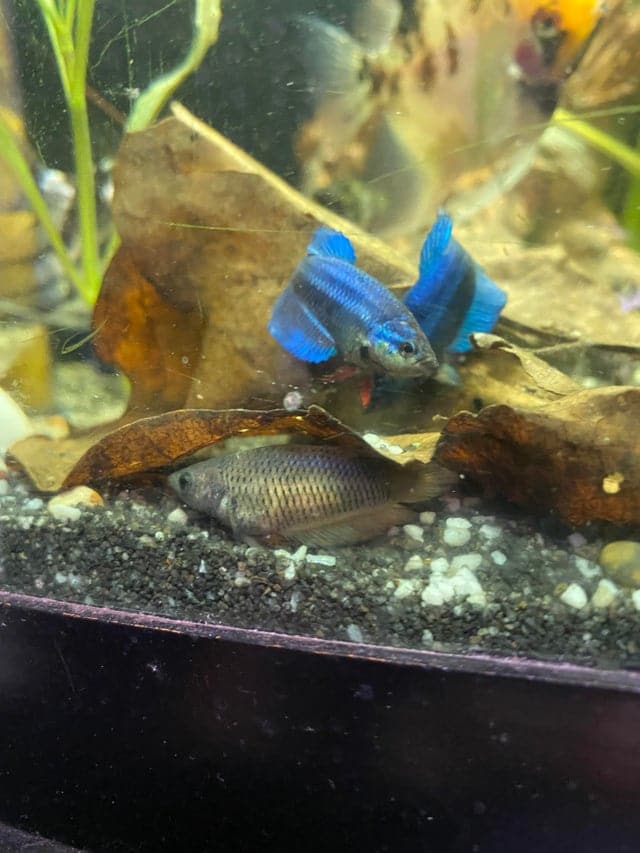
The only time you might see some aggression is if you have a pearl gourami male and female or more than one male. Male pearl gouramis may spar with each other, circling and dancing in vigorous threat displays. But being toothless they rarely cause each other harm.
A male may also vigorously chase a female around and they also defend the area around their bubble nest before and after spawning. But otherwise the pearl gourami community tank is a peaceful and happy place for every fish!
It’s more important to watch out for pearl gourami tank mates that may be on the more aggressive side. Cichlids should be added very carefully because they are too similar in shape to gouramis.
An aggressive cichlid may decide to treat the gourami like a competitor. And unlike gouramis, cichlids have thick lips and teeth that can cause damage to their tank mates. Dwarf cichlids, on the other hand, make good companions since they are much smaller and very different in color.
Small community fish are all a good match as well, including tetras, danios, rasboras, and livebearers. Just be mindful of the differing water quality some of these fish need. Most tetras, for instance, love the same warm, acidic conditions as pearl gouramis.
But many danios prefer cooler water and livebearers often like alkaline conditions. But if you manage to keep the conditions close to a pH of 7.0 (neutral) then you can house just about any of these fish together!
Pearl gouramis are mostly invertebrate safe as well. They won’t molest adult shrimp, though a full grown pearl gourami may try and pick at baby dwarf shrimp. Snails and other invertebrates also won’t be bothered by them.
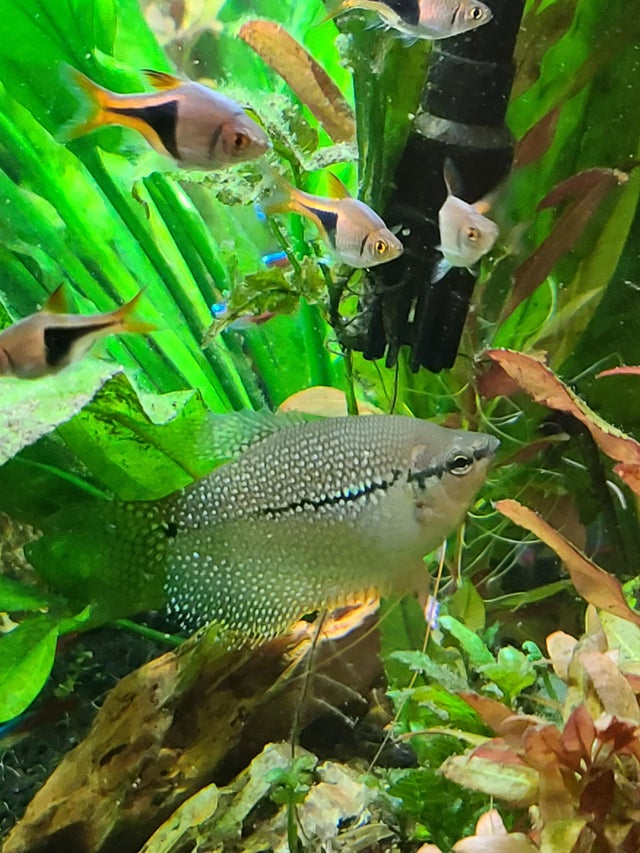
Good Pearl Gourami Tank Mates:
- Tetras, Danios, Livebearers, Angelfish, Killifish, and other Community Fish
- Dwarf Cichlids
- Corydoras, Otocinclus, Plecostomus, and other Bottom Dwellers
- Shrimp, Snails, and other Invertebrates
- Other Gouramis (with caution)
Breeding Pearl Gourami
Sexing Male and Female Pearl Gourami
Is your pearl gourami male or female? When they are young it can be very difficult to tell since they all have the same silvery color when only 1 or 2 inches long.
But as your pearl gourami reach sexual maturity the differences become very obvious. Even when not ready to breed the males have a yellow, orange, or red breast and stomach. Whole a female pearl gourami will often have some orange or red along the anal fin her belly will almost always remain silver. She will also tend to be a little plump all of the time.
Male pearl gourami also have fin extensions along the anal fin and often have a bit of blue, green, or purple along their flanks. Females can have some of these colors too but never as bright as a male.
Caring for Pearl Gourami Fry
Spawning pearl gouramis and caring for the fry is a little trickier than some other aquarium fish. The spawning is straightforward but the fry are very tiny. Too tiny to eat baby brine shrimp nauplii, in fact. Instead, you need to feed them infusoria for their first week.
Infusoria is a generic name for the myriad aquatic planktonic life that grows everywhere filters are not installed. Since your aquarium likely does have a filter, you will need to grow your own infusoria using this guide!
Once the fry progress to baby brine shrimp and crushed flake food, simply keep them clean and well fed in their own fry rearing tank. While the male pearl gourami will provide parental care for the first few days the other fish will eventually eat any fry that leave the nest and try to fend for themselves.
More Frequently Asked Questions about Pearl Gouramis
Pearl gourami are somewhat social so keeping at least one male and one female together is a good idea. But if you only have room for one in a community tank with other fish your pearl gourami will not be significantly stressed. In the wild they usually only come together for breeding purposes anyway.
The pearl gourami is one of the most peaceful gouramis in the family. Occasionally males will spar with each other, especially if there are females in the tank. But they never take their aggression out on other fish, nor do they usually do any damage to each other when sparring.
A full grown pearl gourami can be around 4 to 5 inches long. Rarely do they grow much bigger than this. Overall, pearl gourami size places them in the medium range for aquarium fish!
Pearl gourami don’t need to be kept in pairs. But it is certainly a good idea! The male and female pearl gourami will engage with one another, which is always interesting. And you will see much better colors out of the male when he has a female to impress!

